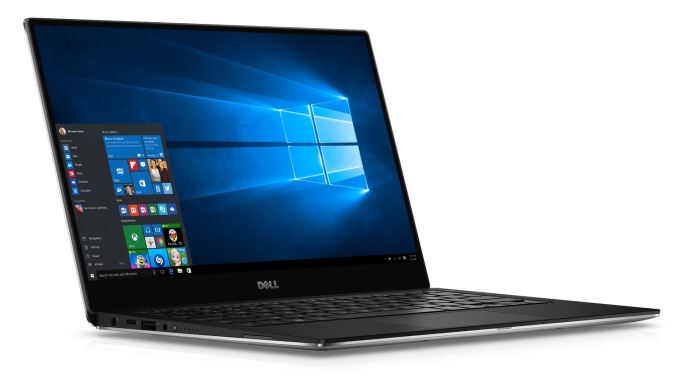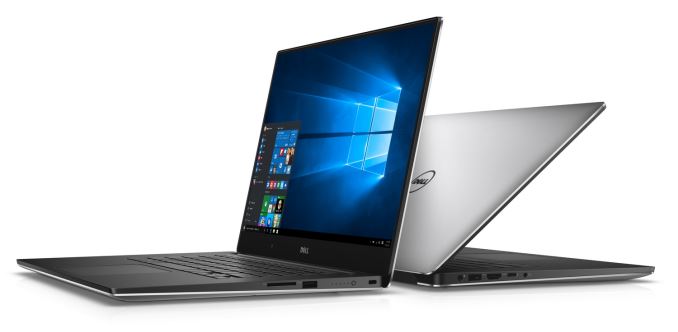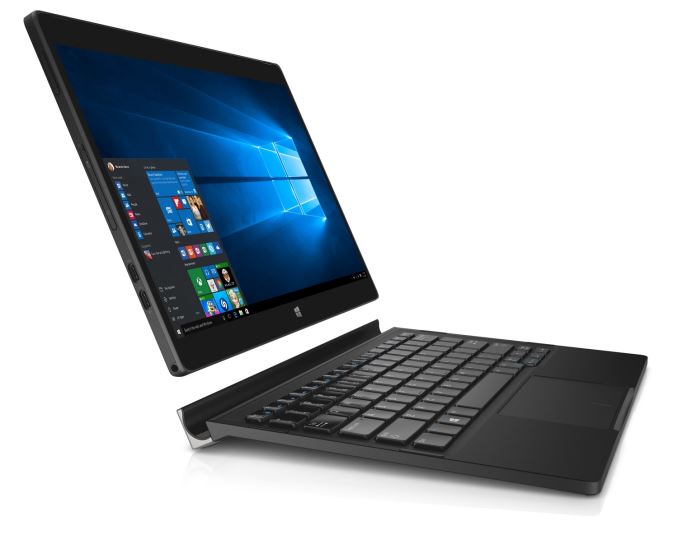Dell XPS Lineup Is Reinvigorated With Skylake On The New XPS 12, XPS 13, And XPS 15
by Brett Howse on October 8, 2015 7:10 PM EST
Dell really put their stamp on the 2015 Ultrabook lineup this year with the Dell XPS 13 with its amazing Infinity Display. They packed a 13.3-inch display into a notebook that would normally house something closer to 11-inches, and no other manufacturer has come close to it this year. Performance was great, battery life was the new benchmark, and other than a couple of foibles such as a camera that points up at your chin, and some aggressive use of Content Adaptive Backlight Control (CABC) there was very little to complain about on the XPS 13. Today, Dell is refreshing the XPS 13 with Skylake, and trying to bring the same amazing design to the XPS 15 and the new XPS 12 2-in-1.
XPS 13
Let’s start with the XPS 13, which should be familiar to anyone who read my review of it. Dell has tried to take the XPS 13 and push it to the next level, and they are starting with Skyake. Dell will offer Core i3-6100U all the way up to Core i7-6600U. This means the GPU will be the Intel HD 520 model, so no Iris options on the XPS 13 range unfortunately. Memory options start at 4 GB and go up to 16 GB of LPDDR3, and storage gets a bump too. The base 128 GB model is still a SATA based SSD, but the 256 GB, 512 GB, and 1 TB models are all PCIe versions. These are evolutionary updates, but the move to Skylake has also given Dell the opportunity to add Thunderbolt 3 to the XPS 13 through a USB Type-C which also supports 10 Gbps USB, VGA, HDMI, Ethernet, and charging.
Battery life was a pretty big part of the Broadwell based XPS 13, and on the 1080p model we got over 15 hours on our light workload. The move to Skylake looks to move that bar even further out with Dell saying the new model is rated at up to 18 hours.
Yes, it is an evolutionary update, but it is an evolutionary update of one of the best notebooks of 2015 so far.
XPS 15
For those that prefer a larger notebook, the XPS 15 has been around for a while now, but when we saw it refreshed back at CES, it was still in the 2014 chassis. Today Dell has brought the look and feel of the Infinity Display to the XPS 15. They have squeezed a 15.6-inch display into the body of a 14-inch notebook. Let’s talk about that display too. It is an Ultrasharp 4K Ultra HD model, which comes in at 282 pixels per inch and has a 350-nit brightness rating. The 4K model also covers 100% of the Adobe RGB color space which is a wider gamut than the typical sRGB space of most notebooks. It offers PremierColor Software as well to remap the smaller sRGB space into Adobe RGB so that colors are not portrayed incorrectly when viewing sRGB content.
The XPS 15 has been the model where Dell steps up the performance to a quad-core version, and despite the smaller chassis due to the Infinity Display that has not changed. The base model comes with the Intel Core i3-6100H which is a dual-core 35 Watt part, but you can also get the i5-6300HQ and i7-6700HQ which are both quad-core 45 Watt CPUs. Up to 32 GB of DDR4 is available through two SODIMM slots, and the XPS 15 offers a discrete NVIDIA GTX 960M GPU as well. You can get the XPS 15 with a spinning drive if you want (I wouldn’t recommend it) or, like the XPS 13, Dell offers PCIe SSDs up to 1 TB. Dell is offering either a 56 Wh or 84 Wh battery, and the larger battery on the 1080p version of the XPS 15 is rated for up to 17 hours. For those that need faster wireless connectivity, Dell also offers a 3x3 802.11ac wireless card. Like the XPS 13, it also features Thunderbolt 3 through Type-C. One thing you do lose by moving to a 14-inch chassis is the room for a dedicated number pad.
XPS 12
The final XPS model announced today is the XPS 12, which is a 2-in-1 tablet with a docking keyboard. Think of this as Dell’s take on the Surface Pro, but Dell has taken a couple of different paths than Microsoft did on their 2-in-1 tablet. First, the display is a 3840x2160 UHD with a smartphone level 352 pixels per inch and 400 nits of brightness and 100% Adobe RGB. There is also a 1080p model with sRGB coverage which should help with battery life. Dell has gone with the latest Skylake version of Core m to power this tablet, with the m5-6Y54 processor which turbos up to 2.7 GHz. 8 GB of LPDDR3 memory is available, and you can get either 128 GB of 256 GB of SATA SSD storage. Keeping all of this powered is a 30 Wh battery.
We tested the Dell Venue 11 7000, which was similar to this in that it had a docking keyboard, but the keyboard added a lot of weight due to the extra battery inside. Dell has taken a different approach here and the keyboard base only adds just under a pound to the 1.75 lb tablet. The keyboard on the Venue 11 7000 was also not great, and the XPS 12 is offering a full size backlit keyboard with 1.3 mm of key travel, which should be a lot better. The trackpad is a glass precision trackpad.
The device itself is made of a magnesium alloy and covered in soft touch paint, and the display has Corning Gorilla Glass NBT.
Dell seems to have gone all-in on Thunderbolt, with this tablet featuring not one but two Type-C connectors with Thunderbolt 3. The 45 Watt A/C adapter also connects over the Type-C, and it is great to see Dell embracing this to get rid of the myriad of proprietary charging connectors that have plagued PCs for decades.
| Dell XPS | |||
| XPS 12 | XPS 13 | XPS 15 | |
| CPU | Intel Core m5-6Y54 (1.1-2.7 GHz dual-core 4.5W Skylake) | Intel Core i3-6100U (2.3 GHz dual-core 15W Skylake) Intel Core i5-6200U (2.3-2.8 GHz dual-core 15W Skylake) (January)Intel Core i5-6300U (2.4-3.0 GHz dual-core 15W Skylake) Intel Core i7-6500U (2.5-3.1 GHz dual-core 15W Skylake) (January)Intel Core i7-6600U (2.6-3.4 GHz dual-core 15W Skylake) |
Intel Core i3-6100H (2.7 GHz dual-core 35W Skylake) Intel Core i5-6300HQ (2.3-3.2 GHz quad-core 45W Skylake) Intel Core i7-6700HQ (2.6-3.5 GHz quad-core 45W Skylake) |
| GPU | Intel HD 515 | Intel HD 520 | Intel HD 530 NVIDIA GTX 960M |
| Memory | 8 GB dual-channel LPDDR3-1600 | 4-16 GB dual-channel LPDDR3-1866 | 8-32 GB dual-channel DDR4-2133 |
| Display | 12.5" 1920x1080 sRGB 12.5" 3840x2160 Adobe RGB |
13.3" 1920x1080 sRGB 13.3" 3200x1800 sRGB |
15.6" 1920x1080 sRGB 15.6" 3840x2160 Adobe RGB |
| Storage | 128-256 GB SATA SSD | 128 GB SATA SSD, 256 GB, 512 GB, 1 TB PCIe SSD | 500 GB - 1 GB HDD, 256 GB, 512 GB, 1 TB PCIe SSD |
| Battery | 30 Wh | 56 Wh | 56 Wh 84 Wh |
| Ports | Thunderbolt 3 x 2 (Type-C) Headset SD Card Reader |
Thunderbolt 3 x 1 (Type-C) USB 3.0 x 2 Headset SD Card Reader |
Thunderbolt 3 x 1 (Type-C) USB 3.0 x 2 Headset HDMI SD Card Reader |
| Dimensions | Tablet: 291 x 193 x 8 mm 11.46 x 7.6 x 0.31 inches Tablet plus Keyboard: 291 x 198 x 16-25 mm 11.46 x 7.8 x 0.63-0.99 inches |
304 x 200 x 9-15 mm 11.98 x 7.88 x 0.33-0.6 inches |
357 x 235 x 11-17 mm 14.06 x 9.27 x 0.45-0.66 inches |
| Weight | Tablet: 790 g 1.75 lbs Tablet plus Keyboard: 1.27 kg 2.8 lbs |
1.2 - 1.29 kg 2.7 - 2.9 lbs |
1.78 - 2.0 kg 3.9 - 4.4 lbs |
| Price | $999+ | $799+ | $999+ |
Dell was already at the forefront this year with their notebook design, so it’s great to see them take that same design and apply it to the XPS 15. The XPS 12 looks to be a decent tablet with a good looking keyboard dock, and that has been one of the biggest issues with convertible tablets with attachable docks so I am excited to see this in person and give it a try. The notebooks will be available on Dell.com starting today, and the tablet will be coming in November.
Source: Dell













99 Comments
View All Comments
nerd1 - Friday, October 9, 2015 - link
You will have enough vertical space with 15.6in display.Spuke - Friday, October 9, 2015 - link
One word: eGPU.BMNify - Friday, October 9, 2015 - link
I was thinking about going for Surface Book till now but XPS 15 refresh has completely changed my decision, First of all i get a big 15.6 display in an awesome 14inch laptop chassis, less than 2KG weight and much more powerful components compared to Surface book's Ultrabook parts:1. CPU Differences: The Intel i7 H 45 Watt part used in Dell XPS is a much more powerful than the Surface book's intel i7 U 15 watt part.
2. GPU Difference: XPS 15 gets a powerful Nvidia GTX 960M with 2GB VRAM compared to cut-down, neutred Surface Book custom GPU which is most probably a cut-down Nvidia 950M with 1GB VRAM.
Then the most important thing is price, XPS 15($1000-2150) costs much less than Surface Book($1500-2700) and at the same time uses much more expensive Intel and Nvidia parts. People have option of getting a XPS15 with 1080P matte display or 4K Glossy touch, 1TB basic HD or 1TB SSD, 32GB ram and bigger battery.
digiguy - Friday, October 9, 2015 - link
XPS 15 is more compelling for those that don't need a large tablet for reading magazines, annotating etc. Having said that. 960m is quite close to 950m and miles away from, say, 970m. I have read strange things about configuration possibilities (no SSD with the full HD version etc.). Let's hope they turn out to be false...mobutu - Friday, October 9, 2015 - link
EXCEPT that the SurfaceBook probably has a cut-down crippled variant of 950m, closer to 940m level of performance (aka crap performance) and thus miles away from the regular full-power 960m in XPS15 ...digiguy - Friday, October 9, 2015 - link
what do you know?BurntMyBacon - Friday, October 9, 2015 - link
I've seen plenty of rumors that say the Surface Book has either a 950m, a cut-down 960m, or some "ultrawide" low clocked maxwell variant that isn't directly related to either. I haven't seen anything that suggests one is more likely than the other (except that I doubt nVidia would fab a new/custom chip for such a low number of units). It does seem that everyone expects 1GB vram, though.In this thread, I've seen "probably a 950m ...", "most probably a cut-down Nvidia 950M", and "probably has a cut-down crippled variant of 950m, closer to 940m level of performance ...". I would really like a link to the information behind these comments. I'd love to join in on the speculation. [joke]It seems the Surface Book is getting worse by the hour. At this rate, by the end of the week, I expect the discreet graphics chip will perform worse than the Intel integrated graphics while halving the useful battery life.[/joke]
Joking aside, it would be good to get some confirmation on this one as I know more than a few people who apparently have more dollars that sense who are looking to get a Surface Book. The "it's not even close to worth the money" argument doesn't seem to work. The 12" Dell here looks really nice and has some possibilities, but I'd be able to sell the idea better if I had better information on what exactly they are giving up.
BMNify - Friday, October 9, 2015 - link
It is not good to say "more money than sense" for people's personal preference, some people may not need powerhouse specs and may be they like the sleek, magnesium chassis of surface book and the versatility of 360 degree hinge and ability to use as a tablet for some time. Many people won't even need any dGPU and should be perfectly happy with intel HD graphics version which costs $1500 (128GB SSD) or $1700 (256GB SSD).BurntMyBacon - Friday, October 9, 2015 - link
I actually got that "more money than sense" from one of the people I'm referring to. He's watching me type this right now. He has money. He wants what he wants. He understands that there are cheaper and (in many ways) better alternatives. His use case doesn't really call for a surface book. He doesn't think it makes sense to by the surface book. However, that is exactly what he's going to do. He does actually really like the build quality of the surface lineup, which is probably why he's going for it. However, he has found a few others that he likes as well.I wasn't suggesting that there isn't a use case for the Surface Book. Just not for the people I'm referring to. I actually have a use case myself that justifies it quite well. I just don't see myself parting with that much cash to do it at the moment. There are other ways to meet my use case if I need to do it now. Currently, I plan to keep saving until either I can afford it comfortably, it comes down in price, or a cheaper (equal or better) alternative presents itself. I'd like to get my hands on a Core M system for a week to see if it has enough muscle for my tastes. I need at least 8GB or RAM, though.
BMNify - Friday, October 9, 2015 - link
If your friend can afford it then he should go for it because in the end affordability, expensive and cheap are all relative terms which differs from person to person. The Surface Book does look awesome and has very good and widely appreciated Magnesium chassis and not to forget that awesome display with 3:2 aspect ratio and the 13.5 inch size means it has very good vertical display space too, i will say the display itself warrants the purchase as almost everyone is sick of 16:9 displays.Hope you can get it too after few months but i think you are looking at Surface pro 4 as Surface Book does not come with Core M CPU, the base model of surface book has an i5.